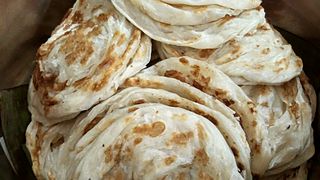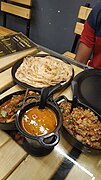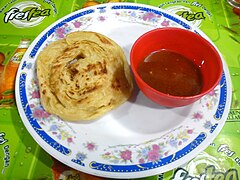 Malabar Porotta | |
| Alternative names | Porotta, Barota, Malabar Porotta, Kerala Porotta, Ceylon Parotta |
|---|---|
| Type | Layered Flatbread |
| Place of origin | South India, Sri Lanka (as Ceylon Parotta) |
| Region or state | Kerala, Jaffna (as Ceylon Parotta) |
| Associated cuisine | Kerala Cuisine, Sri Lankan cuisine |
| Main ingredients | Maida, ghee/oil |
| Ingredients generally used | Eggs, salt |
| Variations | Roti Canai |
Parotta or porotta (Malayalam: പൊറോട്ട) is a layered South Asian flatbread made from refined flour, eggs and oil. It is commonly seen in South India, especially in the states of Kerala[1][2][3][4] (as Malabar Porotta; Malayalam: മലബാർ പൊറോട്ട), and Tamil Nadu,[4] as well as in Jaffna in Sri Lanka (as Ceylon Parotta)[2][5] Variants of the bread spread by Indian Muslim traders and by indentured labourers from the British Raj[6] are popular in South Asian, South East Asian and Caribbean countries like Malaysia,[7] Indonesia, Singapore, Thailand, Brunei, Mauritius, Maldives, Guyana and Trinidad and Tobago under the names roti canai,[8] roti prata, roti thitchu, farata, oil roti or buss up shut.[6]
Porottas are often available as street food[9] and in restaurants, and are also served at weddings, religious festivals and feasts. In the South Indian state of Kerala it is commonly served in roadside foodstalls called thattukadas[10][11][12][13] and in local toddy shops called kallushaaps.[14][15][16][17][18] It is prepared by kneading maida, eggs, oil or ghee and water. The dough is rolled or tossed and stretched into thin layers and then spiralled into a tight dough ball. The ball is rolled flat again and pan-fried, and then beaten to release the flakey layers[19][20] It is often served with a meat curry, such as chicken, goat, beef, or lamb.
History
[edit]Archaeologist and culinary anthropologist Kurush F Dalal says that the Malabar Porotta is likely to have come with Arab traders from ancient West Asia. He explains: “Kerala has always had trade links with West Asia, right from the pre-Islamic period. So, this must have travelled with the sailors and traders and found a place in North Malabar’s culinary palate.” He points out that though porottas are made of refined flour, Kerala is not a wheat producing state and so its origins clearly lie beyond the seas. Food journalist Sonal Ved stated that Persia, Central Asia and the Middle East have their own versions of layered flatbreads, which adds credence to this theory.[1][2][3]
Muslim traders, and later migrant laborers from Southern India are said to have spread its popularity in South East Asia, giving rise to the Roti Canai (so named allegedly after the city of Chennai in Tamil Nadu), Roti Prata and other variants.[7][2][8]
Indentured labourers from British India also introduced the bread to the Caribbean, where it is called the "buss-up-shut roti" referring to the way the bread is beaten after cooking to free up the layers until it looks like a 'bust-up shirt', as well as to Mauritius, Maldives and Guyana, where it was given the names farata and oil roti.[6][2]
The Ceylon Parotta is said to have originated in the Tamil-populated Jaffna region of Sri Lanka, migrant workers from there who were employed at the Tuticorin port in India are said to have introduced it to coastal Tamil Nadu. Variants popularized in Tamil Nadu are the smaller, circular Coin Parottas, and Kothu Parottas made of chopped up leftover Parottas mixed with spices, eggs and chillies.[4]
Gallery
[edit]-
Round spiralled dough ball which gives Parotta its flaky layers.
-
Hot Parottas
-
Kothu Parotta (with Chicken gravy)
-
Roti canai, also known as roti parotta from Southeast Asia.
See also
[edit]References
[edit]- ^ a b Nagarajan, Saraswathy (5 January 2024). "Kerala's signature dish, the Porotta, from Kanhangad to Kaliyikkavila". The Hindu. ISSN 0971-751X. Retrieved 27 October 2024.
- ^ a b c d e Ghose, Sandip (27 August 2023). "Paratha, parotta, prata: How a humble flatbread went global". The New Indian Express. Retrieved 27 October 2024.
- ^ a b "A Taste of Kerala: The Malabar Parotta". Outlook India. 27 January 2023. Retrieved 27 October 2024.
- ^ a b c "How the parotta became South India's favourite flatbread - CNBC TV18". CNBCTV18. 17 July 2020. Retrieved 27 October 2024.
- ^ "Malabar To Ceylon: The South Indian Parottas You Must Try". Slurrp. Retrieved 27 October 2024.
- ^ a b c Elder, Kara (24 June 2018). "Buss up shut: The Caribbean roti with a catchy name". Washington Post. Archived from the original on 18 August 2022. Retrieved 27 October 2024.
- ^ a b Loh, Yi Jun (22 May 2019). "The Indian Roti that Became Malaysia's National Bread". TASTE. Retrieved 27 October 2024.
- ^ a b Kirch, John (31 July 2009). "Roti Canai - Kuala Lumpur takes a flatbread to new heights". Wall Street Journal. Retrieved 27 October 2024.
- ^ Saravanan, T. (18 January 2013). "Flavours from the footpath". Retrieved 22 December 2019.
- ^ "Visiting Kerala? Here's why you should eat at a thattukada". Onmanorama. Retrieved 27 October 2024.
- ^ "7 Iconic Dishes You Must Eat From the Famous Thattukadas in Kerala". www.holidify.com. Retrieved 27 October 2024.
- ^ Jose, Jasmin (9 December 2019). "The Kerala 'Thattukada' (Street Food) Experience". The Culture Store. Retrieved 27 October 2024.
- ^ "Hot and happening". The Hindu. 8 August 2014. ISSN 0971-751X. Retrieved 27 October 2024.
- ^ "Kerala Toddy Shop - Toddy Shops Where You Can Dine with Family". Kerala Toddy Shop. 22 October 2023. Retrieved 27 October 2024.
- ^ Bruner, Joel (30 April 2020). "Toddy Shop Food Experience for Kerala's Most Tasty (and Spicy) Meal". Migrationology - Food Travel Blog. Retrieved 27 October 2024.
- ^ Vyas, Niviya (16 July 2024). "Toddy-Kallu: Kerala's Intoxicating Cultural Heritage". The Culture Gully. Retrieved 27 October 2024.
- ^ admin (28 March 2016). "India Off the Beaten Track: Exploring Kerala Toddy Shops". On Foodie Trail. Retrieved 27 October 2024.
- ^ "Why an afternoon in a tiny toddy shop is the ultimate foodie experience in Kerala". Lonely Planet. Retrieved 27 October 2024.
- ^ "Kerala Paratha Recipe". 10 August 2013.
- ^ Kannampilly, Vijayan (2003). The essential Kerala cookbook. Penguin Books. p. 179. ISBN 0-14-302950-9.








